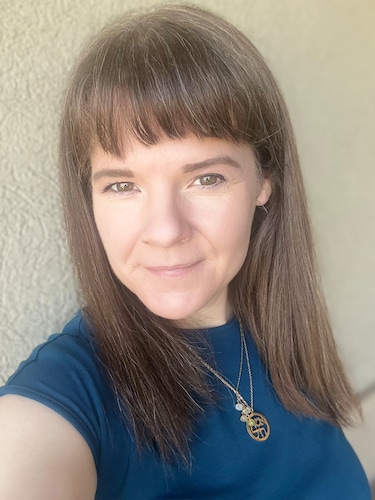When Latter-day Saint mother of four Kristine Anderson read The (London) Times profile of Ballerina Farm’s Hannah Neeleman — a fellow church member and influencer with 10 million followers on Instagram alone — she experienced a “visceral” reaction.
The July 29 article, controversial for its depiction of Neeleman as a dutiful wife to a controlling husband, was “gutting in its familiarity,” the 43-year-old Rexburg, Idaho, resident said. This was particularly true when it came to the part of the story about the aspiring dancer’s switch to stay-at-home mom after becoming pregnant while studying ballet at Juilliard.

(Kristine Anderson) Writer Kristine Anderson says the narrative the reporter presented in the Hannah Neeleman profile was “gutting in its familiarity,” particularly the portion that dealt with the Juilliard-trained ballerina becoming a stay-at-home mom.
Growing up in The Church of Jesus Christ of Latter-day Saints, Anderson said she believed that education for women was viewed as “secondary” and that her “purpose as a woman was solely fulfilling the role of motherhood.” Not until struggles with infertility complicated her plans did a divine revelation about her own inherent worth lead her, she said, to question and ultimately shed that painful narrative.
Now, reading about Neeleman’s life as the mother of eight with no nanny (The Times story attributed the decision to go without child care to Neeleman’s husband, Daniel, the son of airline titan David Neeleman), Anderson “just felt suffocated” all over again.
Hannah Neeleman, known as Ballerina Farm, has since released a video statement, describing the British article as an “attack” on her family and assuring followers she is not “oppressed.” That same day, she updated her website to add more details about how she and Daniel “began to discover our love of agriculture” while living in Brazil. Reporter Megan Agnew, for her part, doubled down on her portrayal of the marriage in a follow-up story with additional details of her day with the Neelemans.
(Bridget Bennett | The New York Times) Hannah Neeleman, last year’s Mrs. American pageant winner, with her family during the Mrs. World beauty pageant at the Westgate Hotel and Casino in Las Vegas in January 2024. Online, Neeleman goes by the name Ballerina Farm, and millions of people watch her almost daily videos depicting her life with her husband and children in the countryside 30 miles from Salt Lake City.
As a writer, Anderson took to social media and the blog Wheat & Tares to share her frustrations reading the piece. The pushback Anderson received from Latter-day Saint women, including feminist friends, “shocked” her. Many, she realized, felt personally injured by the tone of the story, which they interpreted as a broad, sneering swipe at stay-at-home mothers everywhere.
This divided response, as it happens, extends far beyond Anderson’s own circle.
In the weeks since the article buzzed through the internet, The Salt Lake Tribune has spoken with nearly 20 women — the majority current Latter-day Saints, others former members. These conversations, plus interviews with researchers and a survey of dozens of blog and social media posts, suggest The Times profile — not to mention Neeleman’s entire social media presence — has fractured large chunks of the church’s U.S. female membership, scrambling long-held alliances while simultaneously reinforcing many economic and racial fault lines.
“You have women,” said religion scholar Janan Graham-Russell, who find power through and genuinely want a life that adheres to “traditional gender roles,” while others are more focused on ideas of “freedom and oppression.”
The result, she said, is “they’re having two different conversations.”
(Janan Graham-Russell) Scholar Janan Graham-Russell stresses that many of the women debating the meaning and message behind the article and Hannah Neeleman's social media presence are "having two different conversations,” divided by how they define freedom, power and oppression.
‘Nothing but an inspiration’
For readers like Anderson, The Times profile confirmed in their minds what they had suspected all along: Neeleman represents yet another devout Latter-day Saint woman who sacrificed her dreams on the altar of the benevolent patriarchy because she was told that’s what God wanted her to do.
“Trapped in a gilded cage she built for herself but now her husband has the key,” was one Latter-day Saint’s assessment (the individual, a mother of five, asked not to be named due to personal ties to the influencer’s family).
Others, meanwhile, rushed to Neeleman’s defense, describing the life she presents on social media — meals made from scratch and babies strapped to her chest — as the “dream” and its pursuit a choice by a woman whose goals evolved after having kids.
“Nothing but an inspiration,” said fellow Latter-day Saint influencer Espino Sosa, known as Mama Sosa. The 25-year-old especially applauded Neeleman’s ability to manage being both a business owner (Neeleman and her husband run a company mailing farm-raised meat and home goods) and mother.
Still others called into question the author of the profile and her seeming distaste for Neeleman’s lifestyle, which readers said seeped into the article. Included in this group was Neylan McBaine, a longtime advocate for greater inclusion of Latter-day Saint women in the Utah-based faith, who viewed the story as “an egregious pursuit of an agenda.”
A ‘polarizing myth’
All of which begs the question: How did a woman who actively avoids making political statements and whose social media feeds are mostly videos of her tending to chickens and children find herself at the epicenter of one of the internet’s hottest debates?
Part of it, said Meg Conley, a journalist whose work focuses on the intersection of care work, culture and capitalism, has to do with wider debates about women and their place in society.
“The lifestyle [Neeleman] presents is one we have been taught is the American traditional lifestyle,” said Conley, a former Latter-day Saint who still identifies as Mormon. No, life was never exactly like Neeleman’s (19th-century homesteaders did not, for instance, have access to $30,000 stoves or a private gym). Nonetheless, in donning prairie dresses and showing herself collecting freshly laid eggs, she is, Conley said, projecting a “polarizing myth” that some Americans long for and others fear.
Writing in The Cut, columnist Kathryn Jezer-Morton puts an even finer point on it. The Times profile, she writes, “unfolds like a nightmare to many readers — the kind of reality that we might all have to endure if we were suddenly transported to the 1950s, before Roe [v. Wade], before the pill and before mainstream feminism.”
This debate is particularly fraught for many Latter-day Saint women, said Graham-Russell, for the same reason Kristine Anderson found The Times profile so distressing. And that is that for generations, they have been given a “standardized narrative” that righteous women, given the choice, will opt for a life lived largely within the domestic sphere.
Some of that is beginning to change. After all, the faith’s highest-ranking female leader, President Camille Johnson, who heads the worldwide women’s Relief Society, worked as a high-powered attorney.
(The Church of Jesus Christ of Latter-day Saints) Relief Society General President Camille Johnson opens the 2023 BYU Women's Conference on Wednesday, May 3, 2023, in the Marriott Center on the campus of Brigham Young University in Provo. Johnson worked for decades as an accomplished attorney before accepting the position of top female leader for the worldwide faith.
Still, this historic pressure has left many wondering whether Neeleman’s choice to give up dance was ever really a choice at all — even as others have expressed envy for where she has ended up.
“I can accept that there are aspects that the article did not convey,” said Anna Meredith-Edman, a Latter-day Saint who grew up in Utah but has since moved to Maryland. “However, I think the important thing here is it resonated with people and went viral because we see this all the time in the church.”
The 26-year-old mother of one cited as examples “many close friends” who “have given up careers and ambitions” because that’s what their husbands wanted, and the women believed it was the right thing to do.
“It’s [my friends’] ‘choice,’” she explained, “because they are living in a world and marriage where…there is only one ‘right’ choice.”
At the same time, Conley added, there are legions of women — conservative and progressive, in the church and out of it — who are weary of a world that views the kind of work that takes place in the home as somehow less valuable or important than the work that takes place outside of it.
Graham-Russell concluded: “It’s messy.”
Where race and money fit in
It gets messier, the scholar noted, when factoring in race and socioeconomics.
“For Black women who have historically not had the choice to stay home, there’s some tension between what has historically been taught in the LDS Church,” Graham-Russell said, “and [their] lived experience” in ways that affect how many approach the debate surrounding Neeleman.
Graham-Russell said many Black Latter-day Saint women she has spoken to have been quick to point out the reason Neeleman is able to lead the life she can — one that at least appears to be lived largely in the home surrounded by her children — is because of her wealth.
Others are simply checked out of the debate entirely, said Jalyn Briggs, a 27-year-old Black Latter-day Saint and mother of a 2-year-old living in Provo. Top of mind for her and the women she knows like her: Kamala Harris’ historic run for president and the police shooting of the Black woman Sonya Massey in Illinois.
“Ballerina Farm,” she said, “is not a high priority for Black women and Black LDS women.”
Editor’s note • This story is available to Salt Lake Tribune subscribers only. Thank you for supporting local journalism.










